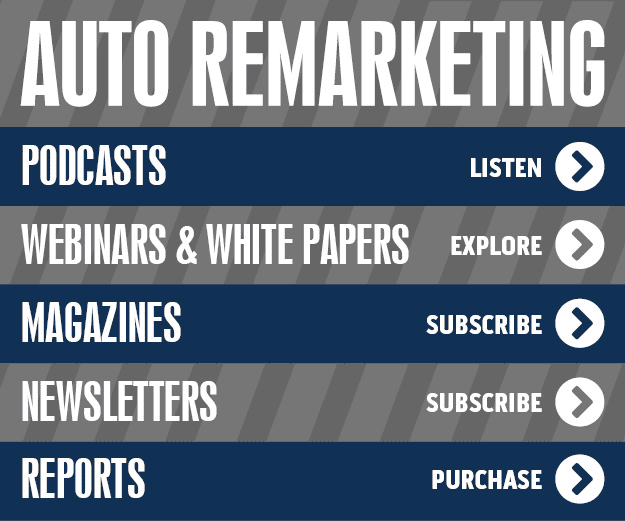Dominion Dealer Solutions highlighted that its equity data mining solution — DealActivator — recently completed significant upgrades to its soft credit pull reporting capabilities, Priority Page mobile functionality and real-time notifications.
Last year, DealActivator released soft credit pull functionality to help dealers achieve conquest sales through equity opportunities in the service drive. With new equity mining processes at work in both the showroom and service lane, the company discovered the need for more visibility in the data behind soft credit pulls became clear.
New soft credit pull reports can offer dealers a complete process summary, enabling dealers to analyze and adjust for greater success. Dealers now have access to three additional reports:
—Soft credit pull summary report can supply dealers with a three-month soft credit roll-up report. This report includes a 90-day view of total pulls, total conversion rates, approval rates, tier charting and comparison views on batch versus manual pulls as well as partial versus complete pulls.
—Firm offer of credit report can keep the dealership compliant with the Fair Credit Reporting Act by providing the dealer with information that the dealer must have on hand to confirm that an offer of credit was provided to the customer.
—Soft credit pull report now gives dealers a review of the soft credit performance per customer pull.
With these new reports, DealActivator now can provide more in-depth reporting than some other soft credit pull equity software. Dealers can analyze performance at the user/customer level to pinpoint strengths and weaknesses within the dealership.
In addition to enhanced soft credit pull reporting, dealers using DealActivator can now work in the Priority Page directly from their mobile devices.
Similar to the desktop application, the mobile version of DealActivator’s Priority Page contains the dealership’s daily contact list with filtering categories. The mobile application can enable text, email, user voice and call features directly from the app, keeping even more of DealActivator’s sales or service drive functionality at dealers’ fingertips.
UserVoice Mobile enhancements also can provide a direct line for service issues or product development feedback.
“Two things have become increasingly evident over the past six months,” said Alan Andreu, general manager of equity solutions for Dominion Dealer Solutions.
“First, the interest in greater process reporting around soft credit pulls; and also, the ever-increasing need for dealers to experience the power of equity mining on-the-go,” Andreu contined. “These enhancements address both needs in a big way, painting an exciting road ahead for our current and future customers.”
DealActivator has also released real-time notifications for its dealers so that sales staff can contact fresh leads while those consumers are still in the car-buying mindset. The new real-time notifications feature alerts the dealership as soon as a potential car buyer opens the dealership’s email marketing communications.
EFG Companies launched a solution called Parts Wizard, a new technology platform aimed at reducing dealer reinsurance exposure, streamlining claims administration and increasing customer satisfaction.
The company explained EFG’s Parts Wizard can automate the manual process of sourcing OEM, aftermarket, remanufacturered and used parts for vehicle repairs. In addition, sourcing parts through the Parts Wizard can enable dealerships to reduce future claims risk with a longer warranty than the standard OEM parts provided by the manufacturer.
All parts sourced through the Parts Wizard, come with an “end of contract” warranty covering the deductible, labor and cost of replacement parts. If any part sourced through the Parts Wizard malfunctions during the term of a customer’s contract, the cost to repair or replace that part will be completely covered without dipping into reinsurance reserves.
“Considering the number of older vehicles on the road, and the potential for consumers to use neighborhood mechanics, EFG’s Parts Wizard offers dealers a better level of control over how their claims are handled, regardless of the level of service provided to their customers by shops outside of their dealership,” said Ken Overly, vice president of operations at EFG Companies.
Traditionally, claims administrators must research vehicle parts with several vendors, on each vendor’s website, before negotiating with a service center. The Parts Wizard can be a search engine that can source parts from all EFG-approved vendors at once, potentially shortening the time it takes to research parts by up to 30 minutes per claim.
In addition, the technology can prioritize results based on availability and price to factor into the decision process.
“The Parts Wizard allows us to better negotiate with service centers outside of dealerships by providing the best price from vendors they likely already use and trust. The service center will either drop their price to match ours, or EFG will purchase the parts directly from the vendors and have them shipped to the shop,” Overly said.
EFG president and chief executive officer John Pappanastos added, “At EFG, we always strive to look beyond the curve to provide industry-leading customer service and efficiency for our clients and our contract holders.
“The Parts Wizard is another example of EFG consistently delivering solutions that the rest of the industry hasn’t seen,” Pappanastos went on to say.
In response to the number of vehicle recalls, technical service bulletins and complaints continuing to set records each year, J.D. Power developed a new application to help auto industry professionals analyze vehicle safety data more efficiently.
On Tuesday, the company launched what it has dubbed SafetyIQ, an online application that can integrate National Highway Traffic Safety Administration information with J.D. Power automotive data. J.D. Power highlighted the results are all searchable by vehicle make, model, year, age and component.
According to Renee Stephens, vice president of U.S. automotive at J.D. Power, “During the past 20 years, more than 428 million vehicles have been affected by safety recall decisions in the United States, with more than 51 million vehicles impacted in 2015 alone, more than in any previous year."
As the auto industry begins to take what J.D. Power described as “a hard look at vehicle safety,” the company insisted it is critical industry leaders, OEMs and dealers have a comprehensive resource that lets them quickly distill key facts from a wide range of disparate data sets.
“With SafetyIQ, we’re bringing together critical information that has been buried within piles of data to help automotive professionals analyze trends and quickly access the information they need to improve vehicle safety,” Stephens said.
J.D. Power highlighted that SafetyIQ is updated daily with the latest data on recalls, technical service bulletins, customer complaints, and investigations. All data is standardized through an easy-to-use interface, allowing auto industry professionals to spot trends, develop benchmarks versus competitors and prioritize areas of focus.
The application also can track completion and overall recall rates to provide an industry-wide view of vehicle safety-related data. J.D. Power pointed out the information is particularly valuable for data on vehicles more than 3 years old, which typically receive the highest volume of complaints and may have fallen off the radar of manufacturers because they are no longer under warranty.
J.D. Power SafetyIQ, powered by SpeedTrack’s patented technology, was developed to help automotive professionals quickly address some of the biggest safety concerns currently facing the industry.
The following is a data snapshot of the current state of recalls and other vehicle safety-related issues, as listed by the company:
—Record number of recalls in 2015: There were 860 vehicle recalls in 2015, the highest number in history, followed very closely by 778 recalls in 2014. In the first eight weeks of 2016, there have already been 84 recalls affecting 8.6 million vehicles.
—Record number of customer complaints: There were more than 76,000 customer complaints about their vehicle in the United States in 2015, following a record 77,000 in 2014.
—Lexus, Porsche, Toyota log fewest complaints: On a sales-weighted basis, Lexus, Porsche and Toyota had the fewest complaints registered with the NHTSA during the 2015 model year.
—Electrical systems drive highest number of complaints: The electrical system has generated the highest number of complaints (more than 120,000) of any system during the past 20 years.
—Peak vehicle age for complaints: During the past five years, most customers have filed complaints when their vehicle hit 7 years of age, on average.
Find more detailed information about the J.D. Power SafetyIQ, visit www.jdpower.com/safetyiq or watch the video at the top of this page.
String Automotive unveiled enhancement to its Dealer Positioning System (DPS) that can help dealerships proactively execute on the marketing data recommendations the system can provide.
Named Strategy in a Box, String Automotive explained that the new feature takes the bedrock of crucial information that lies within the DPS and delivers precise marketing action items, model by model. The result is step-by-step instructions on how to target the right customers geographically, through the right channels, and with the most targeted message to lift sales.
The company also pointed out dealership management can give these action reports to their internal teams or agencies to execute on the marketing recommendations.
“Our String Automotive clients tell us over and over that they just want to sell more vehicles instead of getting caught up in data. We agreed, and that’s why in 2016 String Automotive’s latest services will crunch the numbers and generate your go to marketing plan, while giving you the exact people to target,” said Ken Kolodziej, String Automotive’s co-founder and chief executive officer.
Utilized by more than 250 dealer operations executives, String Automotive’s Dealer Positioning System can combines multiple sources of data from inside and outside the dealership to provide a rich, actionable plan to gain market share in each geographic area. By showing dealership personnel where they can lift market share, which channel will be most effective in doing that, and what message will resonate best with those target customers, String can help dealerships make the most of their marketing budgets.
“There is no doubt that String gives us an advantage over our competitors,” said Kevin Liles, general manager of Edwards Chevrolet in Birmingham, Ala. “Half of the battle is knowing where to focus our efforts, but Strategy in a Box arms us with so much more, the best medium(s), the best message and the perfect targets for ‘no waste’ advertising execution.”
To find out more about Strategy in a Box, go to www.stringautomotive.com. Dealers also can stop by booth No. 6645N at the National Automobile Dealers Association Conference and Expo in Las Vegas beginning on March 31.
On Monday, NCM Associates launched the latest software solution to be added the organization’s business intelligence division; a tool dubbed NCM LiveAudit.
The company said the NCM LiveAudit payables monitoring solution, developed by Intelligent Dealer, is a cloud‐based application that can work seamlessly with dealership management systems to provide a whole new way to control a dealership’s cash flow.
Using a complex algorithm to analyze current monthly spending against dealership averages based on NCM Benchmark data — or against self-defined goals — the LiveAudit system can track and monitor spending to ensure transparency, accuracy and a reduced risk of fraud and financial mismanagement.
“As we all know, profit margins in retail automotive are notoriously slim,” lntelligent Dealer chief executive officer Frank Sheets said. “Monitoring outgoing payments always has been important, but too difficult to do efficiently. We’re pleased to address that limitation with NCM LiveAudit.”
NCM Associates went on to mention the LiveAudit platform can collect historical data and learn more about operator’s business while improving how it analyzes dealership spending.
More than just a spreadsheet, the company insisted LiveAudit is a “robust” tool that also can notify dealers of upcoming contract renewals so they don’t unknowingly auto-renew for another year — or longer — with an unwanted vendor.
Additionally, LiveAudit can store associate pay plans to ensure compensation is aligned with dealership objectives.
“NCM is proud to partner with Intelligent Dealer to introduce another auto-industry game changer,” NCM Associates president and chief executive officer Paul Faletti Jr. said. “Between NCM axcessa, and now with LiveAudit, the quality of information available to dealers is unprecedented.
Faletti added that, “axcessa offers dealers an unbelievable level of visibility to critical dealership operational performance. And there’s never been an easier way to monitor dealership spending than NCM LiveAudit.
Through solutions like these, we’re happy to help our clients gain some peace of mind knowing exactly where their hard‐earned dollars are going,” he went on to say.
NCM will demonstrate the LiveAudit system and offer presale discounts at during the upcoming National Autombile Dealers Association Convention & Expo at booth No. 3013C.
To reserve a spot, register online at www.ncmassociates.com/signup.
It appears the demands stemming from millions of recalled vehicles flowing into dealership service bays are catching up with franchised stores.
The J.D. Power 2016 U.S. Customer Service Index (CSI) Study showed satisfaction with dealer service related to an automotive recall declined for the first time in six years.
According to the study released on Wednesday, the drop in satisfaction this year — which comes on the heels of a record number of recalls — stemmed from customers feeling that dealers do not give the same level of attention to recall work as they do to non-recall maintenance and repairs.
The study measured customer satisfaction with service at a franchised dealer facility for maintenance or repair work among owners and lessees of 1- to 5-year-old vehicles.
More than 51 million vehicles were recalled in 2015, according to the National Highway Traffic Safety Administration. As recall numbers soar, the study revealed customer satisfaction with recall service dropped to 781 on a 1,000-point scale in 2016, down from 789 in 2015.
In comparison, J.D. Power indicated satisfaction among customers with non-recall servicing averaged 809 in 2016.
Compared with customers having non-recall work performed, J.D. Power learned that owners having recall work done are less likely to have their vehicle returned to them cleaner and with the same settings as when they brought it in and less likely to be contacted by the dealer after the service is complete.
“While it may be tempting for dealers to focus more on repair or maintenance work, recall customers represent both an opportunity and a risk to the brand and dealer,” said Chris Sutton, vice president of the U.S. automotive retail practice at J.D. Power.
“There is a need for consistency in the service experience, regardless of the reason for the visit,” Sutton continued. “A lack of consistency, particularly for recall work, can damage customers’ perceptions of the brand and negatively impact their likelihood to recommend and repurchase the brand.”
The study showed overall customer satisfaction, which is based solely on the first three years of ownership, with dealer service averaged 854 in the luxury segment in 2016, up from 852 in 2015, and 797 in the mass market segment, up from 792.
The 2016 U.S. CSI Study is based on responses from more than 72,000 owners and lessees of 2011 to 2015 model-year vehicles. The study was fielded between October and December.
Five other key study findings
Along with the impact of recalls hitting the service bays, J.D. Power highlighted five other study findings that might interest franchised dealers.
1. Wait time
An hour or less is the magic number.
The study found that 70 percent of all service customers are willing to wait between one and two hours to have their vehicle serviced. Additionally, 17 percent of service customers will wait less than an hour or not at all for service, demonstrating the importance of providing loaner vehicles and offering shuttle service, as well as amenities in the waiting area.
J.D. Power mentioned customer satisfaction averaged 835 when the wait time is less than one hour and 40 minutes, and dipped to 756 when the wait is longer.
2. Service with a smile
The study revealed service satisfaction improves by 44 points when a service advisor greets customers within two minutes of their arrival. Yet, 27 percent of customers told J.D. Power they had to wait longer for a greeting.
3. In search of the elusive tire customer
In the first five years of ownership, the components that customers most frequently replaced during the past 12 months are
—Front wiper blades: 25 percent
—Tires: 22 percent
—Brake pads: 6 percent
—Rear wiper blades: 6 percent
—Batteries: 5 percent
Among these items, J.D. Power found that tires are the only replacement component that customers are more likely to have replaced at a non-dealer facility than at a dealer facility. Analysts explained why dealers should take note of this finding as their ability to retain customers for tires is important.
Among customers who purchased tires at a dealership, 40 percent said they “definitely will” repurchase the same brand compared with 31 percent of those who purchased from a non-dealer.
4. Dealers need to get on the text message bandwagon
J.D. Power pointed out that dealer service communication overwhelmingly takes place either in person at the dealership or over the phone as only 2 percent of all customers currently receive service updates via text message or email.
Yet, the study showed 37 percent of Gen X customers and 38 percent of Gen Y customers prefer to receive service updates via text message or email. Even 22 percent of Baby Boomer customers prefer text or email communication, according to the study.
“The willingness to communicate according to customer preference is a tremendous opportunity to increase satisfaction,” J.D. Power said.
5. The value of getting it right the first time
J.D. Power determined the vast majority of customers who take their vehicle in for service — 94 percent, in fact — indicated that the dealer fixed it right the first time.
However, among the 6 percent of customers indicating the service work was not completed right on the first visit, the study showed satisfaction drops to 611, which is 207 points lower than among those whose work was completed right the first time.
The most frequently cited reasons for the vehicle not being fixed right the first time included:
—Work performed didn’t correct the problem: 28 percent
—Dealership could not find the problem: 22 percent
Highest-ranked nameplates
Audi ranked highest in satisfaction with dealer service among luxury brands with a score of 874. Following Audi in the luxury ranking were Lexus (869), Cadillac (863), Mercedes-Benz (857) and Jaguar and Lincoln in a tie (856 each).
Mini came in highest in satisfaction with dealer service among mass market brands with a score of 858. Rounding out the top five mass market brands in the ranking were Buick (849), GMC (830), Chevrolet (818) and Hyundai (814).
Here is the complete rundown:
Luxury Brands
Audi: 874
Lexus: 869
Cadillac: 863
Mercedes-Benz: 857
Jaguar: 856
Lincoln: 856
Luxury Brand Average: 854
Infiniti: 852
Porsche: 848
BMW: 844
Volvo: 837
Land Rover: 831
Acura: 829
Mass Market Brands
Mini: 858
Buick: 849
GMC: 830
Chevrolet: 818
Hyundai: 814
Nissan; 813
Kia: 811
Toyota; 809
Volkswagen: 805
smart: 804
Mass Market Brand Average: 797
Subaru: 793
Honda: 789
Mazda: 786
Mitsubishi: 785
Scion: 780
Ford: 777
Chrysler: 775
Dodge: 754
Fiat: 747
Jeep: 744
Ram: 728
Do you ever wish you could reach out to your former customers, perhaps with something to remind them you’re still available or have deals available for them, when they step onto one of your competitors’ lots?
Automotive Mobile Solutions might have just the thing for you. AMS announced the launch of its LeadsBeacon Apple and Google Wallet software platform, which can notify your loyal customers via its geofencing technology with offers while they may be shopping in a specified region.
"Loyalty geofencing, also known as proximity marketing, is the new challenger and soon-to-be champion of automotive mobile digital marketing," said John Possumato, founder of Automotive Mobile Solutions. "Better yet, it's not too late to be an early adopter."
So how does it work? Basically, dealers receive permission to send alerts to customers when they accept an initial offer, whether that’s for a discount coupon, giveaway, digital business card or loyalty “punch” card, which creates a digital “pass” to their Apple or Android wallet.
The initial offer can be presented to your customer via internet link, QR code, text link or social media. Subsequent offers are then sent to the customers that opt in whenever they cross a pre-established geofence or within range of a beacon that triggers the alert.
"Beacons are inexpensive devices that range from the size of postage stamp to the size of your hand, with a range of 20 to 250 feet," Possumato said. "You could place one outside your competitor's lot to recapture sales customers or near the local oil change shop to send service offers. If you wish, you can place one in every vehicle in your showroom."
Interested? Check out AMS’ site with more information here.
U.S. dealerships were buying and selling at rapid rates last year, fueled in part by Berkshire Hathaway’s giant acquisition of the Van Tuyl auto group.
According to The Blue Sky Report from Kerrigan Advisors, which released its full-year 2015 analysis on Wednesday, U.S. dealership buy/sell activity reached record highs last year.
According to The Banks Report data cited in the report, transaction activity increased by 17 percent in 2015, bringing the year to a record. According to the report, there were 242 dealership buy/sell transactions last year, compared to 206 during 2014.
Among the franchises being acquired, import franchises saw their market share increase by nearly 10 percent at the expense of domestic franchises, which lost 10 percent market share as compared to 2014, according to The Banks Report and Kerrigan Advisors Analysis.
Kerrigan Advisors explained that this shift came about in part due to an increase in the supply of top import sellers. And although domestic franchises represent 67 percent of all U.S. franchises, they accounted for only 36 percent of the franchises sold in 2015.
“This discrepancy is a result of the large number of domestic franchises, many of which are small or located in non-metro markets where they are fewer buy/sells,” the report stated.
Interestingly, activity by new entrants to the dealer world outpaced public company acquisitions by over four to one, according to the report.
The report lists the five most active new entrants of 2015 as follows:
- Berkshire Hathaway Automotive
- McLarty Automotive
- RFJ Auto Partners
- Fremont Private Holdings
- ZT Motor Holdings
Key findings of the 2015 report include record high valuations, which were partially driven by attractive acquisition financing and the increased importance — and price — of dealership real estate, the report stated.
According to data from The Banks Report and Kerrigan Advisors Analysis, private dealership groups (355 franchises) made 64 percent of dealership acquisitions, while the six public dealership groups (38 franchises) accounted for 7 percent, while new entrants (165 franchises) came in with 29 percent.
According to the report, dealership values maintained historically high levels last year.
“This was in large part due to attractive acquisition financing which helped support high prices, even in the face of potentially peaking dealership profits,” the report read.
Private buyers offered the “most aggressive” pricing, while public buyers “remained disciplined with their offers, perhaps not willing to make any buys that would cut into earnings.
The first half of the year, in particular, was marked by the Van Tuyl transaction, which was the single largest acquisition in auto retail history.
The report contends it was the influence of non-traditional buyers entering the market, such as Berkshire Hathaway’s entrance in 2015, that led new entrants into the industry to outpace public company acquisitions.
“A number of iconic multi-dealership groups came to market in 2015 and were acquired by both established consolidators and new entrants. Faced with this stiffer competition, the publics found it more difficult to compete for larger group transactions, and represented just 7 percent of the buy/sell market in 2015,” Erin Kerrigan, managing director of Kerrigan Advisors, said in the report
“Meanwhile new dealership buyers, including family offices, private equity firms, and public conglomerates, acquired 29 percent of the franchises sold, a stunning accomplishment. We believe new entrants will increasingly shape dealership consolidation and meaningfully impact the future of auto retail,” she added.
In addition to providing data on 2015 Buy/Sell activity, the Blue Sky Report also listed four market trends Kerrigan Advisors believes will “shape” 2016, as listed below:
- New entrants continue to seek platform acquisitions
- Return on investment drives valuations, particularly for larger transactions
- Blue sky multiples are firmer, less dependent on profit potential
- Publics' capital allocation is driven by stock price
“In 2015, dealership valuations rose to historically high levels, new entrants made sizable acquisitions, manufacturers approved numerous multi-dealership transactions, and real estate prices returned to pre-recession levels,” continued Kerrigan. “In summary, it was a year that is hard to beat. While the 2016 buy/sell market is expected to be as active as 2015, we anticipate the proportion of sellers completing a successful sale could decline as industry growth plateaus and dealership earnings come under pressure.”
Insurance Auto Auctions has announced the debut of its Title Procurement Dashboard, a new feature within CSAToday, the company’s online vehicle inventory management and analysis tool.
The Title Procurement Dashboard is the newest member to be added to the IAA Total Loss Solution suite of offerings that aim to help improve customer satisfaction and effectively manage costs during the total loss claims process.
According to the company, the solution helps improve the management of the title-procurement process and provides IAA Title Services customers with the status of their documents to enable the loss claims process to be handled more efficiently.
“The added capabilities of the Title Procurement Dashboard allow insurance carriers to be alerted to delays and problem documents,” said Pat Walsh, IAA’s senior vice president of business development. “The loss to claim settlement timeline is decreased through improved visibility, and this can influence policyholder satisfaction and retention. The faster a total loss claim is settled, the higher probability a policyholder will remain a customer of the insurance company.”
Utilizing the dashboard, customers can identify where they are experiencing problems or delays and then address those individual files that are holding up their timeline targets.
“IAA designed this dashboard feature to build on our comprehensive solution for insurance clients,” said John Kett, IAA’s president and chief executive officer. “We are committed to helping our customers reduce costs, improve cycle times and increase employee engagement within the total loss claims process.”
Dominion Dealer Solutions announced the launch of its Dominion Recon solution on Wednesday, its newest process-based software platform for tracking and managing the used-vehicle reconditioning process for dealers.
Dominion Recon is now available to dealers as part of the company’s Inventory Manager.
“Dealers clearly understand the impact the reconditioning process has on dealerships’ financial performance,” said Todd Price, DDS national operations manager for inventory. “Tools such as Dominion Recon provide the transparency and automation needed to effectively manage this.”
According to the company, dealers using Dominion Recon will see a reduction in time to market and greater accountability and tracking in getting used vehicles prepared for the retail process. They can use the solution to alert and deploy necessary resources and hold dealership departments and service providers accountable for any time-related delays.
For more information about Dominion Recon, visit Dominion Dealer Solutions’ site here.












